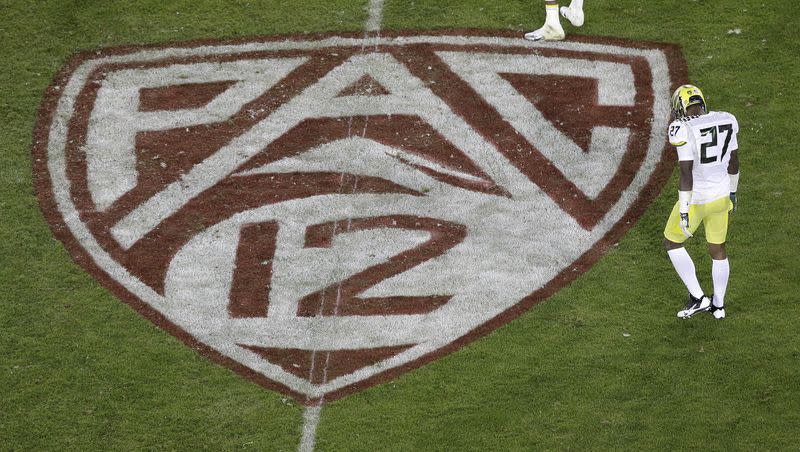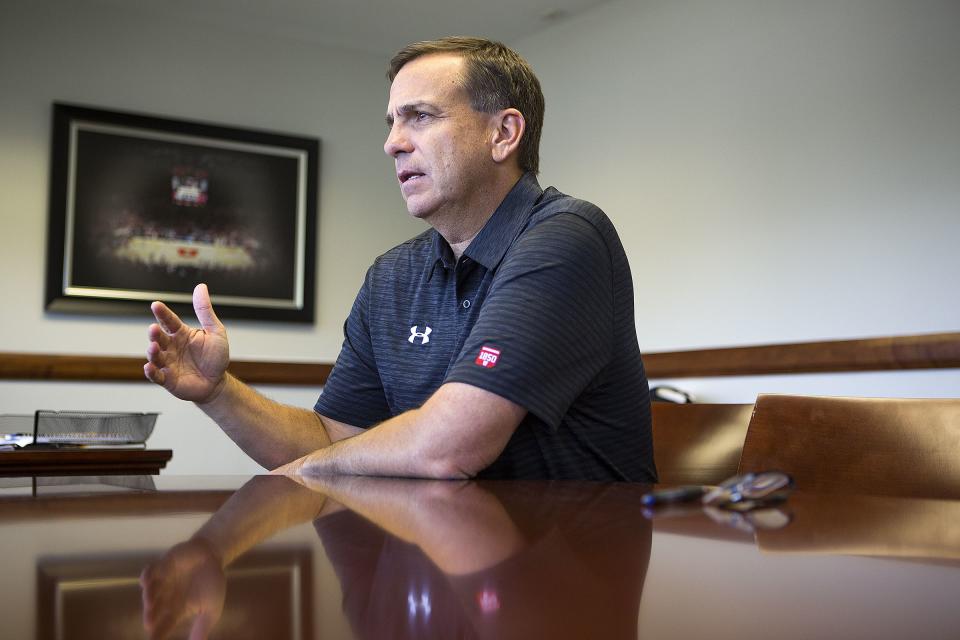Pac-12 bosses go on media offensive

- Oops!Something went wrong.Please try again later.
Eureka. We have dialogue.
We appreciate that University of Arizona president Robert Robbins and Utah athletic director Mark Harlan have gone on the offensive.
Behold, they speak.
In a kind of media blitz this week, Robbins gave extensive interviews to CBS Sports, the San Jose Mercury News and The Athletic. In Salt Lake City, Harlan opened up during an interview with KSL Radio, hosted by former Ute and NFL quarterback Scott Mitchell.
The most extensive of these reports can be found in a piece by Dennis Dodd of CBS Sportsline. Harlan’s interview locally is on KSL.com and is summarized in a written piece by Michelle Bodkin. The Athletic report written by Stewart Mandel is behind a paywall but can be found here.
Robbins believes the Pac-12 will be presented with a TV deal very soon and from what he’s been told it will be better than the Big 12, which is approximately $31 million per team without USC and UCLA.
Robbins told Mandel: “What I think is going to happen is within the next couple weeks, we’re going to have a deal, and then we’ve got to decide: Is it good enough for us to all take?”
.@MarkHarlan_AD joined @KSLunrivaled to debunk some false narratives surrounding the Pac-12.
He also reiterates that the Pac-12 and the current 10 members are working together and are going to sign a media rights deal soon.
"We have always had a plan." pic.twitter.com/jDX6bVtN22— KSL Sports (@kslsports) March 16, 2023
Harlan told KSL he and other Pac-12 administrators were weary of outside voices setting the narrative both locally and nationally. Thus, when a piece appeared last week on CBS Sports with a Pac-12 doomsday tone, he came out with his “Give me a break” tweet.
Harlan spoke about how the Pac-12 media deal has been a complicated, time-consuming exercise that has taken patience and a lot of work, and that short-circuiting negotiations with rumors and attacks on league leadership is unproductive and frustrating.
“I’ve been clear all along — the other schools in our conference have been clear all along that we’re together. We’re 10. We’ve said it. We’re working hard with our commissioner to get this deal done. It’s a complicated deal. There is structure and high expectations with ADs and certainly the presidents and chancellors for the commissioner to nail this thing so we can march forward,” said Harlan.
Related
In response to Pac-12 rumors, Utah’s athletic director says ‘Give me a break.’ Good for him
Who leaked that the Pac-12 was talking to Apple? And why that is important
Robbins confirmed, as has been reported, that he and other Pac-12 presidents have talked with Big 12 commissioner Brett Yormark and other Big 12 presidents.
Robbins described this as leaving doors open in case the number that is presented for the upcoming media deal comes way short of the mark ($31 million). If it is a million or two short, it shouldn’t matter. But if it is $7 million to $10 million less than the Big 12, anything could happen.
“A number doesn’t mean anything until it’s a written contract,” Robbins told CBS Sports. “In Mississippi, they would say, ‘They’re about to fixin’ to give me something.’ They haven’t quite done it yet. We have to get a real in-writing offer.”
Arizona State president Michael Crow echoed Robbins’ and Harlan’s theme in a statement that read in part: “There have been no discussions with the Big 12 conference on moving. I mean, there’s been discussions between everyone everywhere on all things related to where our conference is going and where stuff’s going to end up and what’s happening. We are committed to the Pac-12.”
After taking arrows from everybody all week, Dennis Dodd comes away with by far the most comprehensive interview with Arizona President Robert Robbins, who very much leaves the door open for the Big 12 if George doesn't come through. https://t.co/ADkhS8ptno
— John Kurtz (@jlkurtz) March 16, 2023
Harlan’s interview was founded in faith and hope that the league’s solidarity to stay together is genuine and trustworthy.
None, however, could predict in absolute terms that all members would sign over their grant of rights for a determined length of time.
There is a clear steppingstone path of what must transpire for the Pac-12 to get itself on a path to future prosperity in an ever-changing media market.
First, a media deal must be reached and accepted.
Second, the schools must grant their media rights to that TV broadcast partner.
Third, the league will decide if it will add other members, rumored to be San Diego State and SMU and possibly two other schools if it goes that far.
Robbins believes the backbone of the media deal will be ESPN, however, a streaming partner could be added.
Related
But there are issues that complicate the deal, such as the league owing Comcast $50 million of overpayment for regional coverage from 2012 through 2017.
There is also the question of unequal revenue sharing, which has been reported as part of the discussion, a plank pushed by several members believed to be Oregon and Washington.
Robbins believes there is a 95% chance that things will be worked out for a league TV deal that will meet expectations.
But he’s also allowing a little wiggle room. His school would be a welcomed addition to the Big 12 for a myriad of reasons, including its basketball program shoring up the Big 12’s dominating acumen in that sport, as witnessed in national rankings and current NCAA Tournament seeding.
Bottom line this week, however, is the openness and contribution by Robbins and Harlan to counter the narrative that’s shadowed the league the past nine months.
Stay tuned.
There will be an interesting conclusion. The Pac-12 went on the offensive this past week.
Some day.


